Editor's note: The opinions in this article are those of the author's and not NRCA.
Perhaps one of the most significant developments in the low-slope commercial roofing industry during the past 15 years is the increase in the awareness and adoption of the "cool" roofing concept. Light-colored, reflective thermoplastic roof membranes have been used in Europe since the 1960s and in North America since the 1970s, and companies that pioneered the introduction of these materials continue to innovate.
Despite the track record of some cool roof technologies, such as thermoplastic PVC membranes and certain coatings, some critics within the commercial roofing industry have attempted to cast doubts regarding the fundamental science behind cool roofs, their effects on energy in northern climates and their overall performance.
The cool roofing concept
Cool roofing materials typically are light-colored and reflect a significant portion of incident solar radiation into the atmosphere (reflectance) and quickly release a fraction of energy absorbed by the roof (emittance), resulting in a lower roof surface temperature during hot summer months compared with black or dark-colored roofs. According to Lawrence Berkeley National Laboratory (LBNL), Berkeley, Calif., when using a white or other light-colored membrane, a roof surface can be more than 40 degrees Fahrenheit cooler than a dark-colored membrane, requiring less energy to cool the space below.
Significant portions of our urban landscape are covered with dark-colored parking lots, roads and roofs. These surfaces absorb substantial amounts of incident solar radiation, increasing their surface temperatures. Collectively, they contribute to the urban heat-island effect, whereby the ambient temperature in a city is hotter than temperatures in rural areas. The elevated temperature increases smog formation, among other negative consequences.
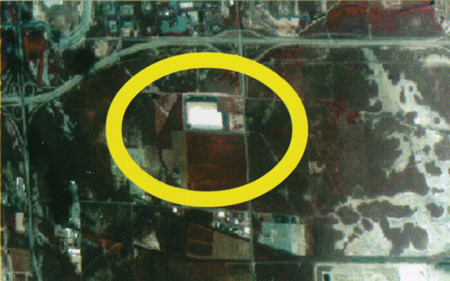
Figure 1: The R.C. Wiley Furniture Warehouse, Salt Lake City, clearly is visible in this aerial photograph.
Photo courtesy of NASA's Global Hydrology and Climate Center
Although some cool roof membranes remain largely unchanged from their earliest days, the recognition of the potential benefits of such materials has grown dramatically since the late 1990s. In November 1998, Newsweek magazine highlighted cool roofs' benefits in its The Millennium Notebook. The article featured the Salt Lake city-based R.C. Wiley Furniture Warehouse. The 865,000-square-feet building clearly is visible in aerial photos (Figure 1); however, its PVC roof makes it almost invisible to heat sensors (Figure 2).
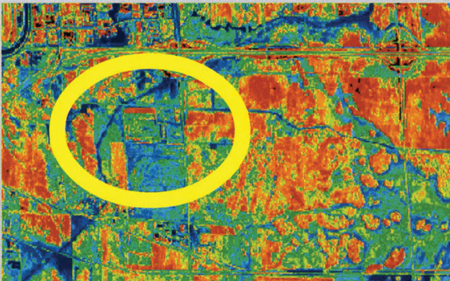
Figure 2: The R.C. Wiley Furniture Warehouse is almost invisible in this thermal-infrared image.
Photo courtesy of NASA's Global Hydrology and Climate Center
In 1999, ASHRAE Inc. was the first to recognize the cool roofing concept in a standard, ASHRAE 90.1, "Energy Standard for Buildings Except Low-Rise Residential Buildings." Since then, various entities have implemented cool roofing strategies or requirements such as California's Energy Commission, the U.S. Green Building Council's LEED® program, the Green Building Initiative's Green Globes® program, and in cities such as Chicago, New York and Toronto.
Studies conducted
LBNL
LBNL was one of the first to measure the energy savings associated with cool roofs. In its 2001 study of a retail store in Austin, Texas, LBNL determined that by switching a black membrane to a white membrane, the average summertime rooftop surface temperature on a facility decreased from 168 F to 126 F. This resulted in peak-hour cooling energy savings of 14 percent and overall annual energy savings of 7.2 cents per square foot. Adjusted for inflation in 2013, this would be the equivalent of 9.5 cents per square foot.
Over time, the energy benefits of reflective roof systems in southern climates have come to be broadly accepted and recognized. If one accepts cool roofs provide energy saving benefits in cooling-dominated climates, the intuitive corollary is reflective roof surfaces are disadvantageous in heating-dominated climates, where one might assume the black, minimally reflective surfaces will absorb the sun's energy in winter, presumably reducing heating energy loads.
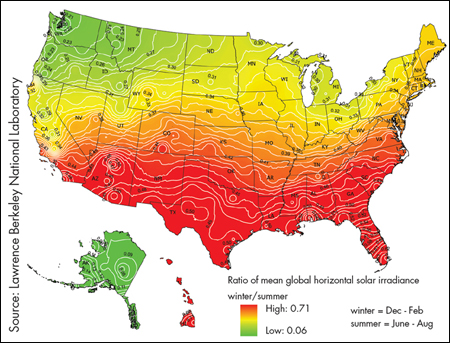
Figure 3: Ratio of mean global solar irradiance
Source: Lawrence Berkeley National Laboratory
However, the answer is not quite as simple as it may first appear. Winter days are shorter than summer days, with more overcast skies. More important, the sun is much lower on the horizon during winter and generates much less heat. As seen in Figure 3, in northern states, winter solar irradiance typically is 20 to 35 percent of the summer irradiance for a given location. Therefore, in northern states, a roof surface receives three to five times more sun during summer than during winter. Furthermore, in many northern states, roofs will be covered by a highly reflective blanket of snow for extended periods of time, further reducing the effect of a darker-colored roof surface on heating energy.
LBNL simulated the potential effect of substituting conventional dark-colored roofs with cool roofs on conditioned commercial buildings in 236 cities. Using the Department of Energy's DOE-2.1E energy model, LBNL determined the differences in cooling and heating energy use between traditional dark-colored roofs and aged cool roofs (assumed average reflectivity of 0.55), considering local building inventory (types, ages, density of construction), local energy sources and other factors.
As expected, the greatest net energy savings were calculated for southwest states such as Arizona, Nevada and New Mexico. Its modeling also showed there can be a "heating energy penalty" associated with using cool roofs in cold climates; however, the magnitude generally is quite small.
For example, in Minnesota, the heating energy penalty was calculated to be an average 0.137 therms per square meter each year for conditioned commercial buildings. Most important, according to LBNL simulations, with the exception of the most remote locations in Alaska, the summertime cooling energy savings more than offset any heating energy penalties, resulting in net annual energy savings. A sampling of some of LBNL's results, including cooling energy savings, heating energy penalties and net annual energy savings, are shown in Figure 4.
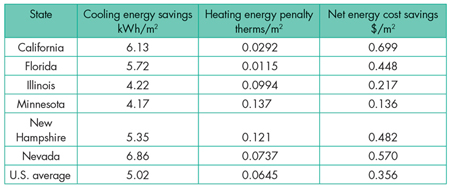
Figure 4: Calculated average annual results for selected states
Source: Lawrence Berkeley National Laboratory
A critical point highlighted by LBNL's retail study was the disproportionate impact cool roofs have during midday, peak demand hours. During the study, LBNL measured cooling energy savings of 14 percent during peak demand hours. Electricity must be used as it is generated; it is not feasible to store electricity on a large scale. Outside peak demand hours, utility companies typically have excess energy capacity. However, at peak times, more utility companies struggle to keep up with demand. Peak energy demand drives power plant construction. As overall energy consumption increases, more utility companies are charging premiums based on electricity rates during peak demand hours to try and influence behavior and even out the load on their systems.
Building cooling systems generally operate using electricity. According to the U.S. Energy Information Administration, buildings currently consume 76 percent of all electricity produced in the U.S. Cool roofs can play a significant role in reducing peak demand across all climate zones. This was one of the driving forces behind California's Title 24 energy code, which mandates a variety of energy saving measures, including cool roofs.
The importance of reducing peak cooling demand only will increase with time. According to the United Nations Intergovernmental Panel on Climate Change, it is anticipated that for most regions in North America, a one in 20-year hottest temperature event likely will become a one in two-year event by the end of the 21st century. Additionally, it projects the one in 20-year maximum daily temperature will increase 2 to 5 degrees Celsius during the same time frame.
LBNL predicts installing cool roofs, cool pavements and trees over about 30 percent of the surface of the Los Angeles basin could reduce the local ambient temperature by as much as 5 degrees Fahrenheit and reduce smog 10 percent. Furthermore, as a result of the lower ambient temperature, the annual building cooling energy savings would be about 50 percent greater than cool roofs alone. The net effect is significant reductions in greenhouse gases, such as carbon dioxide emissions.
Overall, LBNL estimates using cool roofing materials on 80 percent of commercial buildings in the U.S. would result in 10,400 gigawatt-hours of cooling energy savings and about $735 million in overall energy savings. The avoided production of energy saved could reduce carbon dioxide emissions by 6.23 metric tons annually, the equivalent of removing 1.2 million cars from our roads.
University of Wisconsin
In 2007, Engineers at the University of Wisconsin-Madison's College of Engineering's HVAC&R Center conducted a study to determine the effects of cool roofs in Denver and Minneapolis. Their study was based on a typical "big box" retail building. They simulated different combinations of roof colors (black and white), roof insulation values (from none to R-24), and with and without snow cover.
Not surprisingly, the engineers discovered the cooling energy cost benefit of a cool roof decreases with increasing amounts of thermal insulation from 26 percent with no insulation to 5 percent with R-24 value insulation in Minneapolis. Similarly, they found the heating penalty attributable to a cool roof also decreased from 12 percent with no insulation to 3 percent with R-24 value insulation.

Figure 5: Calculated savings for installing a white roof
Source: University of Wisconsin-Madison's HVAC&R Center
Most important, they calculated in Denver and Minneapolis, overall annual energy savings are achieved using a cool roof; the results are summarized in Figure 5. With R-24 value insulation, the overall savings are modest at $16.09 and $10.04 per 1,000 square feet of roof surface in Denver and Minneapolis, respectively. Their analysis demonstrates that even in such northern cities, cooling energy savings can be sufficient to compensate for any heating energy penalties that may be incurred through using cool roof surfaces.
Target® Corp.
Although data published by LBNL, University of Wisconsin-Madison and others are based on modeling and simulations, the results appear to be consistent with the experience of some major building owners such as retail chains. Target Corp., Minneapolis, has about 1,900 U.S. facilities. Energy is a significant driver of Target's operational costs. Target constantly tracks energy consumption and compares actual results of its facilities to the projections generated by its energy models.
For more than two decades, Target has used highly reflective thermoplastic PVC roof membranes on all its facilities. Using cool roofs is an important component of Target's energy-efficiency program. Target has compared cool roofs to black roofs on its facilities in cold climates and has not measured any difference in heating energy consumption. Although the magnitude of the savings varies with location, even for its northern locations, Target achieves net energy savings through using cool roofs.
ORNL
An alternative way to compare roof systems' energy performance is to consider the insulation required to achieve the same performance. In 2012, Oak Ridge National Laboratory (ORNL), Oak Ridge, Tenn., estimated the energy equivalency of cool roofs vs. noncool roofs with additional insulation. ORNL calculated the additional amount of insulation that may be required to achieve "energy equal" roof systems for new construction and retrofit by selecting one city from each ASHRAE climate zone and assigning a default R-value for each facility (see Figure 6) for cool roofs (0.65 reflectance and 0.90 emittance).
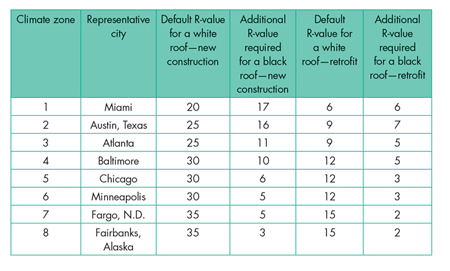
Figure 6: Amount of additional R-value insulation needed for a black roof to achieve energy equivalency of a white roof
Source: Oak Ridge National Laboratory
Using its Simplified Transient Analysis of Roofs model, ORNL calculated cooling and heating energy costs and then determined the amount of additional insulation required under a noncool roof (0.10 reflectance and 0.90 emittance) to have similar heating and cooling costs as the cool roof. As seen in Figure 6, in all climate zones for new construction and retrofit scenarios, additional insulation was required under the noncool roof to achieve the same energy performance as the cool roof. The additional insulation required to achieve energy equivalency with a cool roof ranged from an R-3 value in Fairbanks, Alaska, to an R-17 value in Miami, with an average of an R-9 value in new construction, R-2 to R-7 for the same cities, respectively, and an average R-4 value in retrofit.
Although cool roofs can reduce overall energy consumption, using a cool roof should not be used as justification for using less insulation. Designers should use all available means and technologies wherever practical and cost effective to reduce building energy consumption rather than partially substituting one approach for another.
Cool roofs and soiling
Similar to other materials exposed to weather, cool roofs are subjected to various forms of soiling. The type and degree of soiling depends on numerous factors such as the types of activities occurring around and upwind of the building.
For example, manufacturing, agriculture and some forms of power generation can create significant amounts of airborne particulate that deposits on roofs and other surfaces. Climate may have the greatest effect on the degree of soiling. Hot, humid climates are more prone to microbiological soiling than colder climates or hot, arid regions. For this reason, the Cool Roof Rating Council (CRRC) and Environmental Protection Agency's ENERGY STAR® program call for weathering samples in these three climate areas. Samples are placed on racks on "exposure farms" in these areas and left to weather for three years, the duration generally accepted at which the degree of soiling levels off. The aged values are averaged and reported in each program's rated product directory.
CRRC's rated product directory lists 448 low-slope roof coatings and membranes (single-ply, built-up and polymer-modified bitumen) with an initial minimum 0.70 reflectivity and initial minimum 0.75 emittance. The average initial reflectivity of the 448 products is 0.82. The three-year aged average reflectivity of the same group is 0.69. More than 90 percent of the products have aged reflectance values of 0.60 or better. Less than 3 percent of the products have aged reflectance values below 0.55, the value LBNL uses as the basis for its simulations and assessments.
Studies conducted by LBNL and the National Research Council Canada have shown cleaning can restore practically 100 percent of many products' initial reflectivity. The economic payback of regularly cleaning a roof surface varies widely depending on location, roof size, configuration and construction, local ordinances, etc. Although some owners have integrated regular cleaning into their roof maintenance programs, this rarely is done. However, as shown by LBNL, cool roofs provide energy savings benefits even at aged reflectivity levels.
Cool roof critics
In a 2011 study conducted by Stanford University, Stanford, Calif., scientists questioned a number of LBNL's premises and study conclusions. It is beyond the scope of this article to analyze the points raised in detail, but it should be noted many who reference Stanford University's report always neglect to note a key element. The report notes the wide margin of error in the assessment and specifically highlights the "highly uncertain" warming effect on global climate in their modeling.
Independent studies by the National Center for Atmospheric Research and the University of Perugia in Italy, both published in 2010, show that, if anything, LBNL's projections of the greenhouse gas reduction benefits are conservative and underestimated.
Many associate, whether intentionally or inadvertently, the relatively recent recognition of the energy and urban heat-island effects of cool roofs with products being relatively new to the market, and by extension, unproven. Although this may be true for some thermoplastic materials, it definitely is not the case for all. Thermoplastic PVC roof membranes, which always have been light-colored and highly reflective, were introduced more than 50 years ago. Since then, many billions of square feet of these materials have been installed throughout Europe and North America. Decades-old thermoplastic PVC roofs continue to perform problem-free in all U.S. climates zones.
It is interesting to read articles questioning cool roof membranes' performance, particularly as the topic may relate to installations in cold climates. Although the articles begin with dire warnings about the perceived ills of such roof assemblies, abstractly referring to "roof failures," the authors rarely provide specific examples. The articles inevitably turn into treatises on good roof design and installation—use more than a single layer of insulation, do not leave large gaps between insulation boards, control excess air exfiltration, use a vapor retarder when required, etc.
Each of these points is sound advice and indeed good roofing practice, regardless of membrane color. For quite some time now, NRCA has maintained a vapor retarder should be considered when the average outside January temperature is below 40 F and the interior relative humidity is 45 percent or greater.
The most recent allegation is cool roofs are prone to unusual levels of condensation. Most roof systems installed in northern climates, particularly those with loose-laid membranes (mechanically attached), installed without a vapor retarder may allow small amounts of warm, moist interior air to condense on the membrane's underside, regardless of membrane color. The minimal condensation that may form typically will dry out during summer without causing harm to roof system components or the building's interior. This wetting and drying behavior has been a fundamental basis of roof system design and performance for many decades. Proponents of black roofs assert cool roofs allow greater amounts of condensation to form and/or the membrane does not heat up sufficiently to allow all the condensation to dry, resulting in moisture accumulation.
SPRI, the trade association representing the single-ply roofing industry, sponsored a field study published in 2011 to investigate the condensation phenomenon. It performed test cuts on 10 roofs during winter months, all located in ASHRAE's Climate Zone 5. All roofs were at least 5 years old and consisted of a single layer of polyisocyanurate insulation applied directly to a steel deck with a mechanically fastened single-ply cool membrane over climate-controlled spaces.
In seven of the 10 roofs, SPRI found no evidence of any moisture. In three of the roofs, it detected surface moisture on the insulation face. No evidence of detrimental effects to the roof assembly was observed. SPRI did not return to the same roofs during the summer to determine whether, as would be expected, the insulation was dry. SPRI also did not open dark-colored roofs under the same conditions to determine whether they exhibited similar levels of moisture within a similar roof construction over a similar occupied space in the same climate.
As previously noted, during the past few decades, Target has standardized its roof systems and only uses highly reflective thermoplastic PVC roof membranes. Target has an exemplary proactive approach to the maintenance and replacement of its roofs, systematically monitoring and tracking them. As a membrane on a given roof approaches the end of its service life, Target pre-emptively removes and replaces it with a new membrane. In doing so, the company is able to simply replace the membrane, while preserving the original insulation. Every year, Target replaces dozens of roofs across the U.S. in this manner. With the exception of localized leakage at punctures or other similar damage, Target does not encounter wet insulation and the existing insulation is left in place to provide decades of more service in all cases.
Poorly designed and/or installed roof systems, regardless of membrane color, will perform poorly. Regarding the potential for condensation in cold climates, the Department of Energy states: "While this issue has been observed in both cool and dark roofs in cold climates, the authors are not aware of any data that clearly demonstrates a higher occurrence in cool roofs."
According to SPRI statistics, during the past decade, about 5.5 billion square feet of thermoplastic (PVC and TPO) roof membranes have been installed in ASHRAE Climate Zones 5 and higher, just under half the total amount sold in the U.S. during the same time period. More than 2 billion square feet have been installed in zones 6 and 7 alone. In addition to Target, many of the leading retailers, typically amongst the biggest facility owners in the country, use cool thermoplastic roofs exclusively on their facilities across the U.S. These numbers speak for themselves.
A bright future
Light-colored thermoplastic PVC roof membranes have been used in the U.S. since the 1970s. Since then, the member companies of the Vinyl Roofing Division of the Chemical Fabrics and Film Association, which represent the leading manufacturers of vinyl roof systems in North America, have sold about 5 billion square feet of vinyl roof systems. These products have track records of proven performance second to none in all climates. The attempts to discredit cool roofs in northern climates do not stand up to informed, scientific scrutiny, and they certainly do not reflect the decades of experience using thermoplastic PVC membranes in these climates.
As the U.S. becomes more energy-conscious, the inherent benefits of these and other reflective roofing materials have taken on a higher profile. In northern climates where the net energy savings may be modest on a given building, peak energy demand reduction and mitigation of the urban heat-island effects are becoming increasingly important, and there is no sign of these trends reversing themselves in the foreseeable future.
Stanley P. Graveline is vice president of technical services for Sika Sarnafil, Canton, Mass., and a Technical Committee member of the Vinyl Roofing Division of the Chemical Fabrics and Film Association.
COMMENTS
Be the first to comment. Please log in to leave a comment.